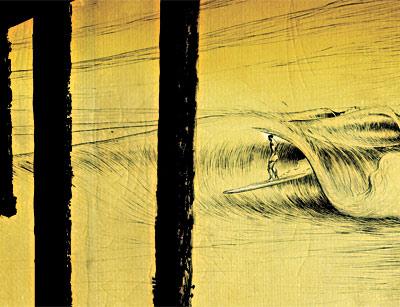Scrimshaw Helps Tell Myth

What’s the recipe for a myth? There’s no one formula, of course, but it seems as though gods or super-motivated humans are usually involved. Someone keeps rolling a stone up a hill, or makes fire, kisses a frog into a prince, gets swallowed by a whale, procreates, dies, gets reborn. A good myth usually requires a powerful natural or supernatural force.
The modern myth is trickier, especially in the supernatural department. It can be harder to recognize in the present, but they do exist and reveal themselves with time.
Earlier this month a filmmaker named Richard Yelland premiered online a documentary titled “12 Miles North — the Nick Gabaldon Story,” a modern myth by any standard, and one that Peter Spacek, an illustrator and The Star’s cartoonist, has helped bring to light in the documentary via his signature scrimshaw work that appears at intervals — art that fits the myth.
In this case, the mythological force is the ocean and the hypnotic spell its waves cast upon surfers. Mr. Gabaldon was born in Santa Monica, Calif., in February 1927, the son of Mexican and African-American parents. He graduated from high school in 1945, and by ’51 he had finished a tour with the Navy and was attending Santa Monica College while working in a polio rehabilitation facility. He was strong, handsome, and addicted to surfing.
The surfing part was unusual for a black man at the time. He had grown up hanging at “the Inkwell,” a beach frequented by blacks that was 12 miles south of Malibu. Because of its perfect wave, “the Bu,” as Malibu was known, was fast becoming the epicenter for surfing in Southern California, and a nursery for many of the sport’s enduring myths.
California beaches were not segregated per se. But, as the film explains, there was enough racism around for the black community to feel more comfortable taking their kids to the Inkwell.
Among the pantheon of surf gods whose immortality was secured during the early days at Malibu were Micky Munoz and city lifeguards including Buzzy Trent and Ricky Grigg, who knew Mr. Gabaldon first while guarding the Inkwell, where Mr. Gabaldon bodysurfed, and then, with the encouragement of Trent, as a fellow board rider at Malibu.
In the documentary, the old guards explain that because a black man would have found it difficult if not impossible to hitch a ride the 12 miles to Malibu, Mr. Gabaldon paddled the distance, surfed, and then paddled back home. If not superhuman, it was at least an amazing feat of endurance that brought the young man into the fold, the first black man to join the pioneering surf community.
But then on June 5, 1951, something terrible happened. It was a crystal clear day, the ocean was blue, and Malibu was breaking perfectly and big. His fellow riders described how they watched him take off and ride with graceful style toward the Malibu pier. The waves were winding north to south down the coast and were big enough to continue breaking through the pier’s pilings.
On smaller days, a surfer might be tempted to “shoot the pier,” weave his board through the pilings, but not when it was big. Mr. Gabaldon’s friends watched as his wave approached the pier with him still riding. Then he disappeared. A frantic search followed, but he was gone. His body was found floating a few days later. A young surfer died, but a hero was born.
The documentary and its clear message about overcoming obstacles was sponsored by the Nike company. It includes interviews with athletes who have risen above other types of adversities. Although vivid in the minds of his Malibu comrades, Mr. Gabaldon’s story has not been widely known until now.
A little over a year ago, Mr. Spacek, a surfer who grew up in California, began translating his drawing skills into the old whalers’ art of scrimshaw by etching images into the fiberglass of old surfboards instead of whale bone. A collection of his work titled “Scratch” was shown at the Out East gallery in Montauk last fall.
He was showing his art at the Sacred Craft surfboard-shaping expo in San Diego earlier this year when Jason Cohen, producer of “12 Miles North,” saw his work.
“Jason saw my scrimshaw and read in my catalog how I scratch into old surfboard fiberglass and drip ink onto the surface to reveal the image. He made the connection between method and story because it was an old story and Mr. Gabaldon had learned to surf at the Inkwell Beach and paddled 12 miles north to surf the better waves at Malibu. It seemed like a good fit to him.”
“12 Miles North” can be viewed online via Theinertia.com or on Nike surfing’s Facebook page.
